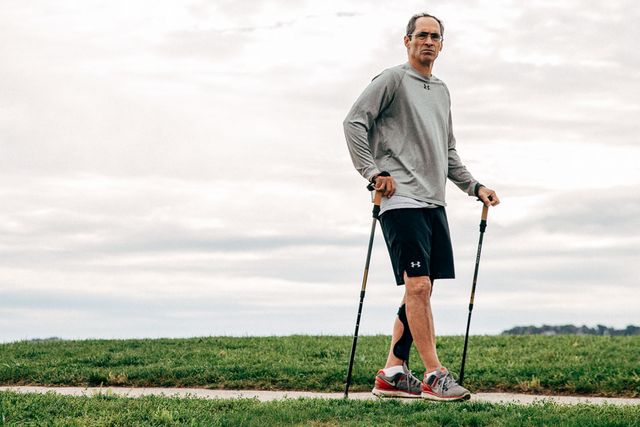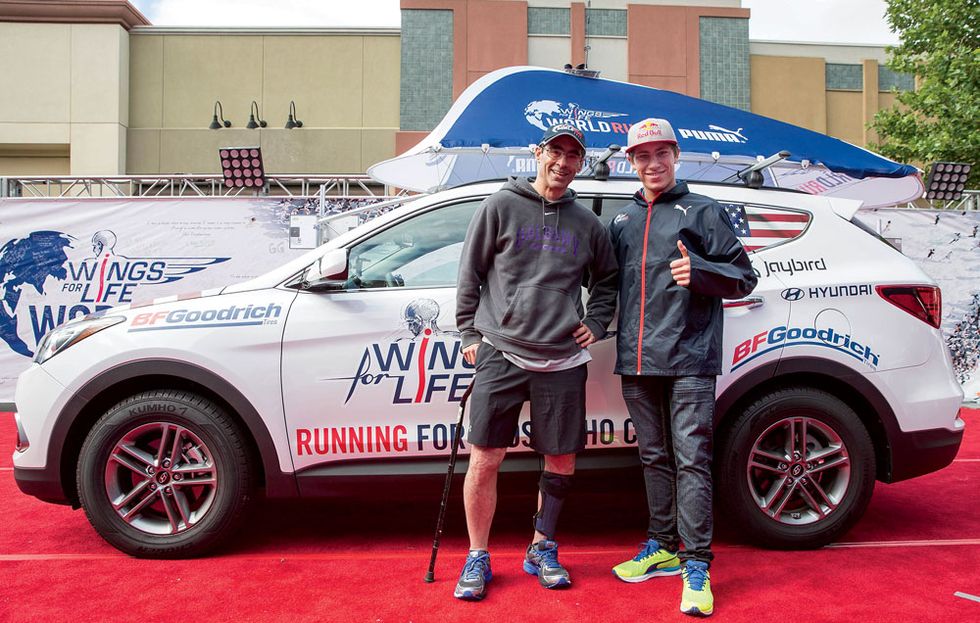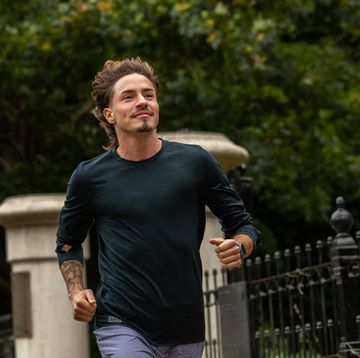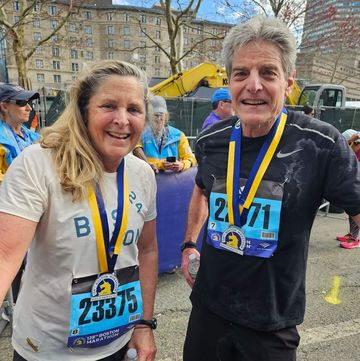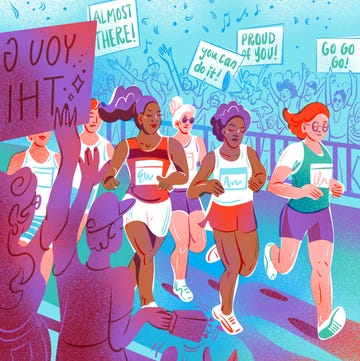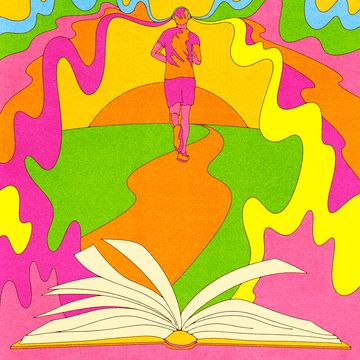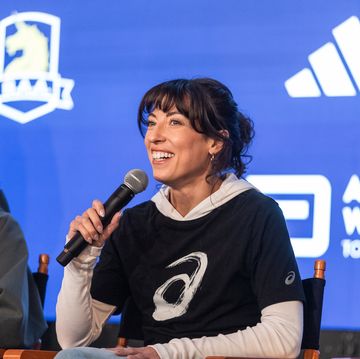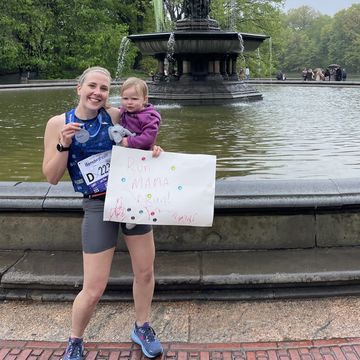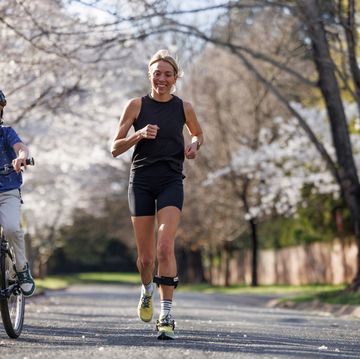It’s 3:45 a.m. at the Westfield Valencia Town Center, an upscale shopping district in Santa Clarita, California, characterized by a central plaza of red pavers, ornamental flower beds, and, at this predawn hour, thousands of runners who’ve courageously heeded their alarm clocks. I am one of them. The Wings for Life World Run road race starts in 15 minutes, and I thread through the crowd in pursuit of Aaron Baker, a former amateur motocross champion and current event ambassador. I want to ask him about certain planned race tactics of mine. I find him standing on a large swath of red carpet with a long white banner behind him inscribed with personal “Why I’m running” messages. Wrestling with some guilt, I tell Aaron that what I’m planning feels like cheating. “It’s definitely not!” a friend of his interjects from the seat of a wheelchair.
The mere fact that I’m racing at all is clouded in conflict and confusion. The hour of the night doesn’t help. And yet there’s some justness that my “comeback” is here, a global event organized and funded by Red Bull to raise money for the treatment of spinal cord injury. The race is run simultaneously at 111 locations in 58 countries at 11 a.m. UTC (Universal Time Coordinated). In Dubai it’s 3 p.m. and 100 degrees. Here in California, just north of L.A., it’s dark and cold. But even that isn’t my chief concern, especially because the event start is supercharged with big stadium lights, frenzied musical entertainment, a PA announcer in a kilt, and, naturally, caffeinated drinks.
No, the principal reason for my anxiety is the white SUV with sponsor decals parked to my left. It’s the dreaded Catcher Car, driven by a pro race-car driver who, in this novel format, gives the field a half-hour head start and then rolls out at an initial pace of 15 kilometers per hour, adding speed every hour. When the car overtakes a runner, sensors read the race bib’s timing tag. For that runner, it’s race over, and he or she can then board one of the courtesy vans for a ride back to the Valencia area. (In my imagination I think of the car as Pac-Man, relentlessly and ruthlessly devouring runners.)
My concern is that my pace is fixed and slow. More specifically, my concern is that of the 2,500 at our Valencia starting line (including a small lineup of wheelchair racers at the front) and another 152,000 worldwide, I will be the first one caught. In this format, the first shall be last.
Hence my urgent ask of moral guidance from Baker, who has worked the last 18 years to overcome a devastating cervical spinal cord injury suffered in a motocross accident. After it, he wasn’t sure he’d be able to eat without assistance. And yet as a self-described “recovering quadriplegic” he has twice pedaled across the country on a bike, won his division in the 2011 USA Cycling Paralympic Road National Championships, and walked 20 miles in six days across Death Valley. I’d visited his new C.O.R.E. Centers gym yesterday, where he is training others to battle like he has. In last year’s World Run he walked with a cane and made it a half mile. This year he is aiming for more.
I’m what you might call a “recovering bipedalist”: proudly upright and moving forward, but new in every way to a world Baker has long and boldly inhabited. My legs are partially paralyzed, so when I’m ambulating, and especially in windy conditions or on unfamiliar terrain, I’m thinking about one thing: not falling.
In pursuit of more speed, I’d purchased two trekking poles yesterday to replace my one banged-up aluminum cane, which was technically all I needed to stay upright. Was that cheating? “Nah,” says Baker. He smiles and tells me to relax. “Use two of them this year, one next, and maybe none the third.”
Sound advice, most likely. So I ignore it. It’s what you do when you race, especially after a very long time. You make rash decisions. Discard logic. When the starting gun sounds at 4 a.m., we all take off in one mad rush, me with a single trekking pole, others in wheelchairs, most just looking like normal racers.
Behind us, the Catcher Car idles at rest. For now.
* * *
For weeks I’d been fretting over an existential question: Can somebody like me race? I’d run (and written about) races my entire adult life until two and a half years ago, when I’d been diagnosed with bone cancer in my lower spine. I emerged from an operation disease-free; unfortunately, I suffered a spinal cord injury in the surgery that resulted in sensory and motor damage to both legs, particularly the left. With the diseased psoas muscle removed from my right leg and my left leg deadened from paralysis, I couldn’t lift either more than a few inches. My spine, rebuilt with rods, screws, and a fused portion of my fibula, didn’t flex well. I couldn’t bend over to pick up a dropped coin.
Nonetheless, I progressed from a wheelchair to a cane and a leg-lifting orthotic to counteract my dropped left foot. I’d been insistently walking a mile a day in my neighborhood, not because I expected to get better, but because I feared getting worse. For a while I timed myself, but stopped earlier this year after I reached a plateau.
Then Jess Smith, a PR rep aligned with Wings for Life World Run, saw a story I wrote in The New York Times and invited me to the California race. She said that because the event had no physical finish line, it empowered every entrant, every result.
I wasn’t convinced.
I thought about the guy I’d seen recently when I glanced up at the floor-to-ceiling mirror at Walgreens, coming down the aisle looking old and wobbly with a flared-out knee on the right and loose hips all around. I had a mild Trendelenburg gait, in the PT parlance, which doesn’t sound bad until you look at the YouTube videos. (Or the Walgreens mirror.) Some days were better than others, however, and some days when nobody was looking at the grocery store and I felt peppy, I’d pick a vacant aisle and try to run a few strides behind a grocery cart. I would feel my legs turning over in quickening succession. Like a runner.
Thinking about the race, I kept coming back to one troubling thing—the unusual format seemed to accentuate my state of severe slowness. But Jess said no, it wasn’t like that at all. Others like me would be there. Yes, there’d be some world-class endurance athletes, some on foot, some in wheelchairs, but she promised all sorts. My sort. Those who had the fire to compete, albeit with a body that felt wrong for a race bib and a starting line. The race, and the act of racing, was a commitment to hope, she suggested. Everyone was welcome.
Recently a friend told me about leading some middle-school kids on a casual bike ride and cautioning one who repeatedly kept charging in front. “Nick,” she said, “there’s no racing.” Nick replied, “I’m not racing, I’m just trying to get ahead of the others.” Nick was unwittingly profound. Racing is complicated: why we do it, how we do it, when we do it. The Wings for Life World Run website suggested participants have a distance goal. The idea: We weren’t racing each other so much as we were racing a finish line that was pursuing us.
Dubiously, I challenged myself to prepare. First, it was from my suburban Boston house to one of the main streets in town and back; then to the baseball field and back. I counted my steps in a six-minute test used for recovering stroke patients to see how I measured up. I studied the biomechanics of walking and running, attempting to understand how to do something I had never thought twice about before my surgery. I collected stories of people who’d defied doctors to make breakthroughs. One of them, a young woman named Victoria Arlen, would be in the race with me in California. She’d been in a wheelchair for almost half of her life but was able to miraculously rise up out of it after relentlessly training for 18 months. She’d been walking for less than a year and decided only a few weeks before I did that she’d like to try to run.
As the countdown to race day neared, I regularly visited the gym to use a treadmill to speed up my gait. I could do 30-minute miles holding on with one hand. As happy as I was to feel the perspiration of a hard effort, I wasn’t sure what “speed walking” on a treadmill in a climate-controlled YMCA had to do with running in the dark with whooping people pregaming with Red Bulls.
So in the last week prior to leaving for Cali, I went to the local track armed with my cane and Strava. I couldn’t remember the last time I was on a track. The last 5K I did was a couple of years before I got sick, a charity race in nearby Ipswich I ran in 27:34.
My best quarter split was 7:54. My overall mile was 33:30. At that rate the Catcher Car would be rolling three and a half minutes before I’d knocked off a mile. That’s if my track time equated to dark roads.
There was a time in my life when I wrote about a lot of unusual adventures I tried that I wasn’t particularly adept at. I attempted to become a whitewater guide for one assignment, even though I was uncomfortable with fast, frothy water. I went into the rain-forest bush of Central America’s Darien Gap, twice, despite being a bumbling outdoorsman seemingly incapable of tying a knot or hanging a hammock. With two bad knees I joined a running club and raced up Mount Washington, one of the toughest hill climbs in the country. The feeling from living those experiences was obviously important because I kept going back for more.
It occurred to me that by joining a race in the middle of the night with a paralyzed lower half and a jacked-up Hyundai bearing down on me, I was getting back to being me.
The origins of the World Run go back more than a dozen years, when Red Bull’s founder, Dietrich Mateschitz, influenced by an injury to a friend’s son, set up the Wings for Life Spinal Cord Research Foundation to find a cure. The World Run would draw attention to the efforts outside Europe, where the company’s headquarters are based. It has funded nearly 500 spinal-injury researchers and 170 research projects as of 2017. Red Bull might not be a company you’d associate with a serious medical moonshot, but I checked. They’re for real.
The first World Run in 2014 had 35,000 participants in 34 locations (including Denver, Santa Clarita, and Sunrise, Florida, in the U.S.). The elite Ethiopian marathoner Lemawork Ketema, running in Austria, ran almost 79 kilometers, narrowly defeating a racer in Lima, Peru. Red Bull had come up with the concept of a car running down runners. It seems weird, but “everyone remembers being chased as a kid, and the thrill you felt trying not to be caught,” says Amy Daugherty, CEO for Wings for Life, USA. “You’re being chased by a car. A professional Red Bull athlete is driving the car. People are shocked but excited.”
As my race begins, the Catcher Car is the least of my problems. Waves of runners stream around me like I am a boulder on a fast-flowing river, and the large field—95 percent of which appeared to be able-bodied—takes off down the road on a course that gets hilly around mile six as it heads west on Route 126.
Then I am alone in the sudden silence of the wide boulevard straightaway of Magic Mountain Parkway. I am in an empty street far from home at 4:05 a.m. I never was a fast runner, but I knew how to push and make myself hurt, chest pounding. The peculiarity of the weakness in my legs is that I can’t produce enough effort to quickly raise my heart rate. There’s no gasp for air from a too-quick-race-start adrenaline surge. The familiar markers of a race are absent. The nagging loss makes my presence here feel not just odd—I’m used to odd—but irrelevant.
Soon, an easy-going Aussie named James Caskey joins me. “Oh, hey, there’s Aaron Baker!” he says, having pivoted around to see if there is, in fact, anybody behind us. Back at the start, Baker and I had made loose plans to do the race together, but it was impossible to stay near him amid the logjam of runners. As we started I was sure I’d seen him race ahead. So the normal response to James’s sighting would’ve been to say, “Oh, cool,” stop, turn around, and wait. Instead, I do what only I would recognize I was doing.
I surge. I would be guilt-ridden later, but can’t deny what I am feeling.
I am racing.
Shortly thereafter, Caskey announces that the Catcher Car has set out. It’s half past the hour, he says rather ominously. The news that the chase is officially underway results in another “surge.” At the same time I abandon my single stick strategy and ask Caskey to fork over my other trekking pole, which I had left in his care. The Catcher Car, at my current rate, is going to run me down in seven or so minutes. I want to get past the 2K mark. On one hand, it is an embarrassingly modest goal; in Italy, this same weekend, a lithe Nike racer is aiming for an incomprehensible sub-two-hour marathon. Me? Well, a plus-2K finish would be faster than my best time at the high school track and the 30-minute miles on the treadmill. The second pole might give me a tad more thrust, along with the helpful assurance I might not face-plant in the process.
I dig in.
Meanwhile, with all races in all countries being tracked in real time by the Wings for Life broadcast team, there is something special going on. In the high heat of Dubai, a guy named Aron Anderson is setting down a furious pace, up with the expected race favorites like the 2:14 marathoner Ketema. He is on track to become the first global winner in the race series—in a wheelchair.
* * *
There had been tears at the start of the race before anybody had even set out, and there are tears at the finish. Victoria Arlen, 22, and her mother, Jacqueline, broke a barrier neither of them could imagine doing even a few years earlier. Victoria has no sensation from the waist down and couldn’t feel her feet, but she ran a mile. Then she walked and assisted wheelchair racers another couple more. When the Catcher Car approached, like me she instinctively kicked. “She started sprinting!” her mom says. “While pushing a wheelchair.” The race reaffirmed Arlen’s next running goal: to finish a marathon.
At the far end of the field, Colorado’s Dan Berteletti had worn everyone down with his metronomic pace. He’d circled 40 miles in his running journal and executed exactly what he trained for—a solid series of sub-6:30 miles. “The game plan for today was to try to run consistently from start to finish, and I really was able to do that,” he says after returning to the start, to his wife’s welcoming arms and the whoops and cheers of the Wings for Life gang. The latter are dashing between the red carpet receiving line and their temporary indoor headquarters, where a massive screen shows the still-unfolding global race. The paraplegic athlete Anderson, in his everyday wheelchair, has outlasted all others and now is on some arid roadside in Dubai with a TV crew capturing his victorious reaction.
“Yeaaahhhhh!” he screams, punching the night sky. He’s ridden 92.14 kilometers over five and a half hours, holding off the Catcher Car even after it accelerated to 35 kilometers per hour. “I had cancer when I was 7, surgery in the back, and ended up in a wheelchair,” he begins emotionally, as raw in pain and love and hope as you’ll ever see. “It’s tough to be in a wheelchair. It can be really, really, really hard. I don’t know if I’ll be able to walk one day, but that could be pretty cool.” Yeah, it had been a “little bit hot,” but heck, that just meant he didn’t have to stop to pee. He flashes a bright smile. “Legend!” someone shouts, and the crowd joins in: “Legend!”
It is uplifting, and for a time I ride that wave. I’d finished my race with an official distance of 2.08K, surrendering to the Catcher Car at 4:38 a.m., shortly after passing a Dairy Queen and a Petco. I’d made my goal, and to my astonishment (I rechecked my calculations multiple times) clocked a 29:24-per-mile pace. In checking the official photo images from the race, I at first don’t appear, which seems impossible with Wings for Life photographers perched on cranes, hanging off motos, and controlling video drones in the sky. Was I so slow that I blended into the backdrop, a shadow racer that caught no one’s eye? Fortunately a bit of grainy, Zapruder-like footage is found, taken by Caskey of my predawn catch. In it I’m muttering, “No, no, noooo!!”
I had imagined the Catcher Car driver to be a villainous soul who enjoyed cratering regular folks’ hopes and dreams, but when I meet him afterward that all washes away. Mitchell deJong is fresh-faced, genial, and 19, a few years younger than my son. He’s a pro race-car driver who’d gone 0 to 60 in 1.9 seconds the weekend before in Memphis, though for this event he never exceeded 20 kph for four-plus hours. He tells me he wished he could’ve gone even slower when he saw people busting a gut to stay ahead of him. Victoria Arlen, Jess the PR rep, wheelchair racers, old and young...everybody let loose a desperate burst as deJong approached, chasing goals only they knew.
The finish-line car wasn’t damnable. In fact, it was inspirational, pushing runners to exceed their limits.
After it caught me, I’d jumped into one of the return-trip shuttle buses. I found myself amid a bunch of sweaty, high-fiving runners riding back to the finish area, where volunteers draped us with medals on red-white-and- blue ribbons. It didn’t occur to me until the receiving line that my fellow bus riders might have wondered how I’d gone step for step with them. “I am jacked,” said one, a native German now living in California, as he soaked up the red carpet adulation in the light of a brilliant sunrise. “I kept waiting on the car, but it never came. I went way farther than I thought I would.” He and hundreds of others wrapped in thermal capes snapped selfies and inscribed canvas banners with why-they-ran words of dedication. “Turning whens into wins!!!” read one. “I run for my surfer boy” was another.
Later that day, I wonder about Baker, whose result showed a DNC (Did Not Complete). Beset with guilt, I call to apologize for ditching him. There are no hard feelings—he’d waited for a friend and was nabbed by the Catcher Car. “It was a race!” he says. “You don’t stop until the checkered flag.” Legend.
The next week, back home on the East Coast, I found the resolve to check the overall race results. Could I really have finished last…in the world? But my 2.08K wasn’t nearly as bad as I’d feared. I cracked the top 100,000, with a 99,008 finish. Naturally I was curious about those who matched my distance. Maria Montserrat Vazquez Moran and I finished in a dead heat, though her race was in Guadalajara, Mexico. Pumelela Matshikwe was the other 2.08. His race was in Pretoria, South Africa. I wondered about their stories, and if they were as pleasantly surprised as I was to find company at that distance.
Back when I was stalled in my recovery progress, I wondered if I’d ever find my tribe again. I had no idea I’d locate them in the middle of the night at random points around the world. So I guess I’ll be back at the race next year—I have an army to answer to now. They’re running with, for, and—if I had to guess, in Aaron Baker’s case—against me.
Three kilometers might be possible.
Todd Balf is a longtime contributor to Bicycling and the author of Major (a biography of Major Taylor), along with several other books, including Complications, a memoir of his recent medical odyssey.
